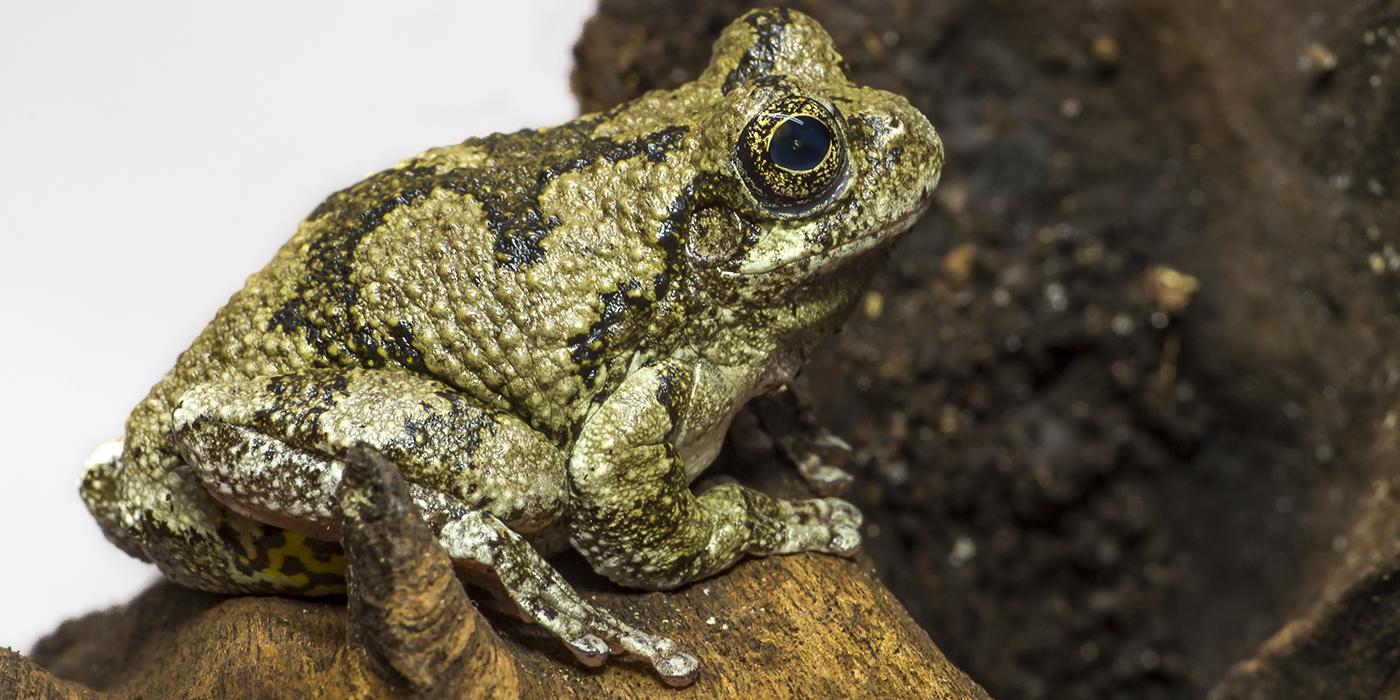Physical Description
The gray tree frog's color changes in response to its environment and activities, and can range from green to gray or brown. The upper surface of the body has a blotchy pattern that resembles lichen. Although the pattern varies, it usually features two dark central patches, which can be green, buff or gray. These frogs have a white spot beneath each eye and a dark stripe from the rear of the eyes to the front of the legs. The snout is short, and the skin is warty and coarse.
The upper surfaces of the legs feature a dark, banded pattern, which contrasts starkly with the bright yellow or orange undersides of the legs. Scientists believe the bright coloration serves as a warning for predators not to attack. The gray tree frog has webbed hands and feet. The enlarged tip of each digit produces an adhesive fluid that allows this species to better grip trees and improves its climbing abilities. The frog's belly is white, although the male reveals a black throat when it is calling.
Like the adult, the gray tree frog tadpole has inconsistent coloring, including different shades of brown or olive green. As tadpoles, they are scarlet or orange-vermilion with black blotches around the edge of the crests. The body and tail are patterned with many specks of black and gold. As the individual ages, it develops its adult coloration.
Size
Adult male gray tree frogs are around 1.25-2 inches (32-52 millimeters) in length. Females are typically slightly larger than males, ranging from 1.5-2.25 inches (38-60 millimeters) in length.
Native Habitat
The gray tree frog's range covers much of the eastern United States, from northern Florida to central Texas and north to parts of southeastern Canada. It is a largely arboreal species that occupies a variety of wooded habitats and is frequently found in forests, swamps, on agricultural lands and in backyards.
Access to trees and a water source is common to all habitats it occupies. When a gray tree frog is young and newly metamorphosed, it usually remains near the forest floor. As it ages, it may transition to living in the forest canopy.
Lifespan
Gray tree frogs typically live for seven to nine years.
Communication
Males emit a loud, musical call, usually after dusk, for as long as four hours. The male uses the call to establish a breeding territory and to find a mate.
Food/Eating Habits
Adult gray tree frogs mainly prey upon different types of insects and their own larvae. Mites, spiders, plant lice, snails and slugs are common prey. They may also occasionally eat smaller frogs, including other tree frogs.
They are nocturnal and hunt in the understory of wooded areas in trees and shrubs. As tadpoles, they eat algae and organic detritus found in the water.
Sleep Habits
Reproduction and Development
A male begins the mating call in early spring, shortly after emerging from hibernation. In the mid-range areas males begin calling in late April to early May. Males call to females from trees and bushes that are usually close to, or overhanging, streams or standing water.
The exact timing of breeding for gray tree frogs varies based on temperature and their location throughout the range. Most reproduction takes place early on, although the calling season lasts from late April to early August. Individuals may mate up to three times in a season.
Males are very territorial and will fight other males to defend their area. Fights may last 30 to 90 seconds and consist of wrestling, shoving, kicking and head butting until the subordinate male retreats. Females instigate mating by approaching a calling male and touching him before rotating 90 degrees.
The individuals engage in amplexus, a mating position in which the male grasps the female with his front legs, as the female deposits 1,000 to 2,000 eggs which are externally fertilized by the male. Since mating occurs while the frogs are floating in water, eggs are deposited into the water in small clusters, which attach themselves to structures via a transparent, mucous outer layer.
Tadpoles usually hatch after three to seven days, depending on the water temperature. About 10 minutes to an hour before hatching, the embryo has to release a fluid to help break down the wall of the egg. Tadpole development depends on water temperature with metamorphosis typically occurring in 45 to 65 days. They become sexually mature after two years.
Conservation Efforts
The gray tree frog has a wide distribution and presumed large population. Threats to regional populations include habitat loss, the pollution of water ways, invasive species and the threat of diseases, such as the chytrid fungus. Exposure to pesticide and insecticide has also been found to negatively affect this species.
Help this Species
- Conservation starts with you! Join a citizen science project, such as FrogWatch or Neighborhood Nestwatch, where you can help collect valuable data for scientists. Encourage your friends and family to get involved too.
- Are you a student? Did you love what you learned about this animal? Make it the topic of your next school project, or start a conservation club at your school. You'll learn even more and share the importance of saving species with classmates and teachers, too.
- Protect local waterways by using fewer pesticides when caring for your garden or lawn. Using fertilizers sparingly, keeping storm drains free of litter and picking up after your pet can also improve watershed health.



